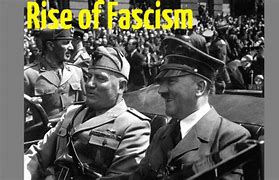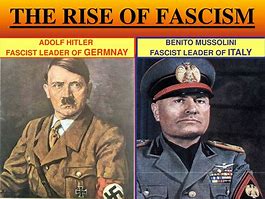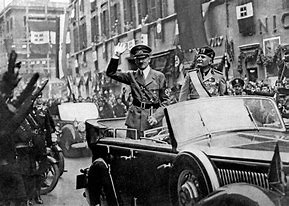Introduction
The early 20th century was a period marked by political instability, economic distress, and societal changes that paved the way for the rise of extreme ideologies like fascism and Nazism. These ideologies would leave a lasting imprint on the world, particularly in Europe, and change the course of history forever. The rise of fascism and Nazism was not a sudden event, but rather a culmination of various political, social, and economic factors. These movements emerged as responses to the volatile conditions of the time, fueled by nationalistic fervor, militarism, and the desire for order in the face of chaos. In this article, we will delve into the origins, development, and consequences of fascism and Nazism, and understand how they shaped the world during the 20th century.
Understanding Fascism: What It Is and Where It Came From
Fascism is a far-right, authoritarian ideology that emphasizes dictatorial power, extreme nationalism, and the suppression of opposition. It seeks to centralize authority under a single leader or party, eliminate political pluralism, and create a homogeneous society through the control of media, education, and the economy. Fascism also promotes militarism and the belief that violence and war are necessary to maintain societal order and expand national power.
The roots of fascism can be traced back to the aftermath of World War I, particularly in Italy, where economic instability, widespread unemployment, and political chaos created fertile ground for extremist movements. The rise of Benito Mussolini and the formation of the Italian Fascist Party in the early 1920s marked the first successful implementation of fascist ideals.

The Birth of Nazism: Ideology and Roots
Nazism, short for National Socialism, was a specific form of fascism that emerged in Germany, largely influenced by Adolf Hitler and the National Socialist German Workers’ Party (NSDAP). Like fascism, Nazism advocated for totalitarian rule, ultra-nationalism, and the supremacy of a single race. However, Nazism added an additional layer of racial ideology, particularly the belief in the superiority of the “Aryan” race and the need for its expansion at the expense of other races.
The Treaty of Versailles, which ended World War I, left Germany in a state of humiliation, economic ruin, and political disarray. Many Germans felt betrayed by the treaty and blamed their government for accepting its harsh terms. Hitler and the NSDAP capitalized on this widespread resentment, offering a platform of national revival, pride, and the promise of a return to greatness. They used anti-Semitism, anti-communism, and nationalistic rhetoric to galvanize support, ultimately leading to Hitler’s rise to power in 1933.
Economic Instability: A Crucial Factor in the Rise of Fascism and Nazism
Economic hardship played a significant role in the rise of both fascism and Nazism. The Great Depression, which began in 1929, had a devastating impact on Europe. Unemployment soared, businesses collapsed, and entire families were left destitute. In Germany, hyperinflation in the early 1920s had already crippled the economy, and the Depression only worsened the situation.
Both Mussolini in Italy and Hitler in Germany promised economic stability and prosperity to their followers. Mussolini advocated for a corporatist economy, where industries would be controlled by the state to ensure production and social harmony. Hitler, on the other hand, pursued a policy of rearmament and public works programs, such as the construction of the autobahn, to stimulate the economy and create jobs. These promises were attractive to many who were struggling to survive during the economic crisis.
Nationalism and the Appeal of Fascism
Nationalism was a powerful driving force behind the rise of both fascism and Nazism. In the aftermath of World War I, many Europeans were searching for a sense of identity and pride in their nations. The humiliation of defeat, combined with economic hardship, created a fertile ground for nationalist ideologies to take root.
Fascism in Italy and Nazism in Germany both capitalized on this desire for national unity and strength. Mussolini promoted the idea of a “New Roman Empire,” while Hitler sought to establish a Greater Germany, one that would dominate Europe and eradicate the perceived threats of other races and ideologies. The idea of national greatness, coupled with the promise of a strong leader who would restore order and pride, was incredibly appealing to those who felt disenfranchised by the political and economic turmoil of the time.

The Cult of Personality: Mussolini and Hitler
At the heart of both fascist and Nazi movements were strong, charismatic leaders who embodied the ideals of their respective ideologies. Benito Mussolini, the leader of the Italian Fascist Party, was a master of propaganda and used his image as a strong, decisive leader to unite the Italian people under his banner. He portrayed himself as a man of action, someone who could restore Italy to its former greatness.
Similarly, Adolf Hitler was the face of the Nazi Party and became the central figure of Nazi Germany. Hitler’s ability to inspire and manipulate the masses through speeches and media was unparalleled. His personal charisma, combined with his ability to tap into the fears and desires of the German people, helped him rise to power and maintain control over the country for over a decade.
The Role of Propaganda in Fascism and Nazism
Both fascism and Nazism relied heavily on propaganda to spread their ideologies and maintain control over the populace. Mussolini and Hitler understood the power of mass media, and they used it to create an image of themselves as omnipotent, almost divine figures. In Italy, Mussolini’s government controlled the press, radio, and cinema, ensuring that only pro-fascist messages were disseminated to the public.
In Nazi Germany, propaganda was also central to the regime’s control. Joseph Goebbels, the Nazi Minister of Propaganda, was responsible for spreading the party’s ideology through newspapers, films, and radio broadcasts. The Nazis used propaganda to dehumanize their enemies, particularly Jews, and to glorify the “Aryan” race. This manipulation of the media played a critical role in shaping public opinion and maintaining the fascist and Nazi regimes.
Militarism and the Militarization of Society
Fascist and Nazi regimes were heavily militarized, both in terms of policy and in their societal impact. Mussolini’s Italy and Hitler’s Germany both pursued aggressive military expansionism, believing that war was a necessary tool for national rejuvenation. In Italy, Mussolini invaded Ethiopia in 1935, while Hitler’s Germany began its aggressive territorial expansion in Europe, starting with the remilitarization of the Rhineland in 1936 and culminating in the invasion of Poland in 1939.
The Suppression of Opposition and Civil Liberties
Both Mussolini’s Italy and Hitler’s Germany were totalitarian regimes that suppressed political opposition and civil liberties. In Italy, Mussolini outlawed political parties other than the Fascist Party and created a one-party state. Political opponents were imprisoned, exiled, or executed. Similarly, in Nazi Germany, Hitler eliminated political opposition, banned all other political parties, and established a brutal secret police force—the Gestapo—to eliminate dissent.
In both regimes, civil liberties were severely restricted. Freedom of speech, freedom of the press, and the right to a fair trial were all curtailed. In Nazi Germany, the regime’s persecution of Jews, political dissidents, and other minorities led to widespread repression and violence, culminating in the Holocaust.

The International Impact of Fascism and Nazism
The rise of fascism and Nazism had profound implications for the world. The aggressive expansionist policies of Nazi Germany and Fascist Italy ultimately led to the outbreak of World War II. Hitler’s invasion of Poland in 1939, followed by Italy’s invasion of Greece and Germany’s invasion of the Soviet Union, triggered a global conflict that would last until 1945.
The Fall of Fascism and Nazism
The defeat of Nazi Germany and Fascist Italy in 1945 marked the end of the fascist and Nazi regimes. The world sought to rebuild in the aftermath of the war, and the atrocities committed by the fascist and Nazi regimes served as a reminder of the dangers of totalitarianism, racism, and extreme nationalism.
Conclusion
The rise of fascism and Nazism in the early 20th century had a profound and lasting impact on the world. These ideologies were the result of a combination of economic hardship, political instability, and social unrest. Through charismatic leadership, propaganda, and militarism, both Mussolini and Hitler were able to seize power and establish totalitarian regimes that sought to control every aspect of society. Their aggressive expansionist policies led to World War II and the deaths of millions.
FAQs
1. What are the main characteristics of fascism and Nazism?
Fascism and Nazism are authoritarian ideologies that emphasize extreme nationalism, totalitarian control, militarism, and the suppression of political opposition. Nazism also includes a strong racial component, with an emphasis on the supremacy of the “Aryan” race.
2. How did economic instability contribute to the rise of fascism and Nazism?
Economic hardship, such as the Great Depression, created widespread unemployment and discontent, which allowed fascist and Nazi leaders to gain support by promising economic recovery, national pride, and stability.
3. Who were the key leaders behind fascism and Nazism?
Benito Mussolini led Italy’s fascist movement, while Adolf Hitler was the leader of the Nazi Party in Germany. Both used charismatic leadership and propaganda to gain power.
4. How did the world respond to fascism and Nazism?
The rise of fascism and Nazism led to World War II, which caused massive destruction and loss of life. After the war, the Nuremberg Trials held Nazi leaders accountable for their crimes, and the world sought to prevent the resurgence of such ideologies.


